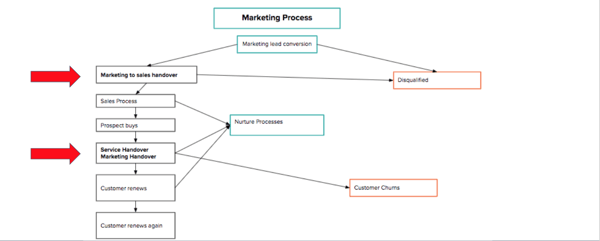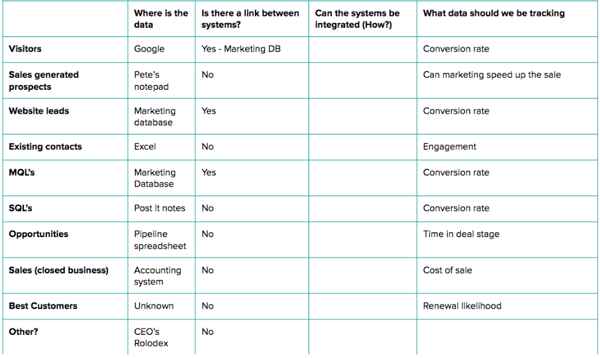Imagine if your marketing platform surfaced exactly how much revenue your activities had driven. This is just the tip of the iceberg in the conversation into why all your integrated technology needs to talk.
This sustained growth means that there’s now a digital marketing tool for everything, while entire libraries have been written on the subject of the best digital marketing tools for growing businesses.
On the constant lookout for apps and platforms capable of improving efficiency, reducing spend, and increasing the ROMI of daily activities? You're spoilt for choice.
"But a tool itself is not the solution," says Chris Grant, our sales services consultant and passionate speaker with over 20 years of industry experience. "This is especially true when a tool doesn’t integrate with the rest of the technology your salespeople or marketing teams are using."
The challenge is three-pronged:
- Are your people working towards a unified goal?
- Does your technology enable your processes?
- And can you connect the dots across your tools to track end-to-end data?
In this article, you'll learn more about all three of these challenges and why it's so important that all your technology talks to one another.
Mapping your marketing tools around your people
A rugby team is made up of 15 positions. That’s 15 moving parts with 15 different jobs. There are teams within teams, but they work together towards a shared goal.
Once your people understand the goal they’re working towards, you can map your technology requirements to make it easier for them.
"From sport to business, focus individual and team efforts on your company's most important goals", says Chris. "Help everyone understand more clearly all responsibilities associated with specific goals, and strengthen accountability by assigning measurable, articulated goals that are visible company-wide."
What are your integrated technology requirements?
If you know what your process is, you can map your technology to it.
The number one process is almost universal across sector and industry: finding and keeping customers. But like the rugby team, every department has their own processes. How do those processes fit together? Are they creating friction for the customer? And which parts could you automate?
-
Aligning your processes starts with discovery. What is actually happening?
-
Group your best customers and define the process they went through. Is it different?
-
Next, map it out. Where are the breaks?
-
Where is the friction? And how can you remove it?

Tools that integrate your customer data
If Nigel gets the most qualified leads but he never hits quota, why is this? Sarah, on the other hand, is consistently over her target. What can you learn from her? Perhaps Pete had closing training but is still struggling to win new deals.
"The quick wins are in the data, but only if you can track it end-to-end’, Chris reveals. "If you’re not sure your company has this level of visibility over its data, ask yourself what data you do have on your customers and where it is. This will reveal how integrated your tools are with one another and where they need to be communicating better."

Unlocking the full value of your integrated sales and marketing tools
There’s also an aside on technology you think your team is using vs. the technology they’re actually using. When your sanctioned technology suite fails to meet the requirements of its users, they will typically resort to their own technology solutions.
Gartner studies have found that shadow IT accounts for 30 to 40 percent of IT spending in corporate enterprises. Shadow IT has nefarious connotations, but in today’s digital landscape where tools are readily available, the use of unsanctioned technology can often be driven by the need to find a workaround.
This is most commonly seen in instances when marketing tools and related technology has been rolled out without consulting the teams that will be using it.
"Your new technology should complement the way your teams are operating, not unsettle them", says Chris. "Take a CRM launch, for example. Include the sales team in the decision-making process, so they are involved much earlier on and actually have a hand in shaping the system they are going to be using."
Integrated marketing tool example: HubSpot Growth Suite
Central to inbound sales, marketing, and service platform HubSpot’s commercial success is the light it sheds in the form of end-to-end customer data. Its joined-up software tracks every touchpoint a visitor makes when visiting a website, so once a visitor has converted into a lead, you have full visibility over the way they interact with your site, revealing actionable insights into the interests, aspirations, pain points and other predilections of each individual prospect.
But while HubSpot recognises the importance of joined-up systems that talk with one another, it also recognises that today’s salespeople and marketers use too many different systems and applications for it to replicate them all on its own.
In order to put those systems first and provide additional value to its users, HubSpot is continually expanding the already expansive list of apps and web services it integrates with, providing its valued customers with as seamless an experience as possible.
The HubSpot Connect programme currently has over 200 officially recognised integrations, while the open API from HubSpot allows you to connect other systems you may need on a case-by-case basis.
Engage in meaningful conversations with your visitors using a suite of integrated sales and marketing software.
Are your tools talking to one another?
Suites of integrated sales and marketing tools facilitate data sharing, joining the dots from a first-time visitor to a lifetime customer so you can do a whole range of helpful things like calculating the cost of customer acquisition, reporting on ROI, and optimising your most effective tactics or channels over time.
"But technology is just a tool, rather than a magic bullet", Chris summarises. "Much like those ever-popular list articles would have you believe, there are literally thousands of tools for you to choose from, but without ammunition, they will fail."
The ammunition here is your decision-making, of course, the why you need certain marketing tools and the how you will use them to improve your people, your process, and your visibility over your customer data. "We’re an industry built on the back of technology", says Chris. "It’s easy to forget that a tool is just that: an appliance, only as useful as the people and the inbound marketing strategy behind it."
Learn how you can use HubSpot to close the data gap and drive repeatable, scalable ROI by downloading our free, 80-page marketing ebook below.
Download How to Generate Leads that Close
Discover proven strategies in our eBook, 'How to Generate Leads that Close.' Elevate your marketing game and transform leads into conversations.


Tom is BabelQuest's Principal Copywriter. He has a PhD in Creative Writing from the University of Southampton and is a novelist with Sparkling Books.


.png?width=50)

.png?width=50)
.png?width=50)


































